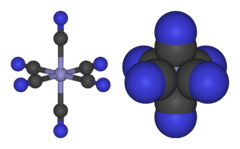This is an old revision of this page, as edited by ZéroBot (talk | contribs) at 12:28, 15 August 2011 (r2.7.1) (robot Adding: ca:Ferricianur). The present address (URL) is a permanent link to this revision, which may differ significantly from the current revision.
Revision as of 12:28, 15 August 2011 by ZéroBot (talk | contribs) (r2.7.1) (robot Adding: ca:Ferricianur)(diff) ← Previous revision | Latest revision (diff) | Newer revision → (diff) | |
 | |
| Names | |
|---|---|
| IUPAC name iron(3+) hexacyanide | |
| Systematic IUPAC name hexacyanidoferrate(III) | |
| Other names ferric hexacyanide; hexacyanidoferrate(3-); hexacyanoferrate(III) | |
| Identifiers | |
| 3D model (JSmol) | |
| PubChem CID | |
| CompTox Dashboard (EPA) | |
SMILES
| |
| Except where otherwise noted, data are given for materials in their standard state (at 25 °C , 100 kPa).
| |
Ferricyanide is the anion . Its systematic name is hexacyanidoferrate(III), in older nomenclature hexacyanoferrate(III). The most common salt of this anion is potassium ferricyanide, a red crystalline material that is used as an oxidant in organic chemistry.
Properties
consists of an Fe center bound in octahedral geometry to six cyanide ligands. The complex has Oh symmetry.
The iron is low spin and easily reduced to the related ferrocyanide ion , which is a ferrous (Fe) derivative. This redox couple is reversible and entails no making or breaking of Fe-C bonds:
- + e →
This couple is a standard in electrochemistry.
Compared to normal cyanides like potassium cyanide, ferricyanides are much less toxic because of the tight hold of the CN to the Fe. They do react with mineral acids, however, to release highly toxic hydrogen cyanide gas.
Uses
Treatment of ferricyanide with ferrous salts affords the brilliant, long-lasting pigment Prussian blue, the traditional color of blueprints.